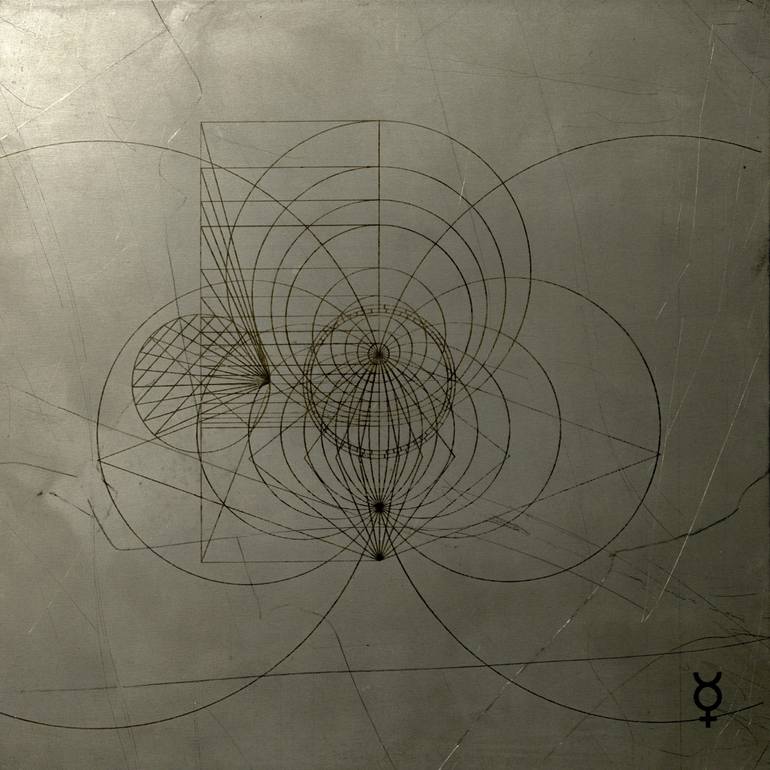


VIEW IN MY ROOM
Where is Here? Mercury • titanium laser Artwork
Mixed Media, Algorithmic Art on Aluminium
Size: 6 W x 6 H x 0.1 D in
Ships in a Box
About The Artwork
. . . . . . . . . . . . . . . . . . . . . . . . . . . . . . . . . . . . . . . . . . . . . . . . . Where is Here? Mercury - titanium laser Inspired by Islamic scholar Abu Ishaq Ibrahim al-Zarqali, I sketched construction lines to create astrolabes for use on each of the other planets in our solar system: Mercury, Mars, Venus, Jupiter, Saturn, Uranus and Neptune (as well as Earth, its moon, and Pluto), supplementing his trigonometric calculations with contemporary NASA data. Variation between the images arises from planetary differences in obliquity to orbit, orbital period and rotational period. . . . . . . . . . . . . . . . . . . . . . . . . . . . . . . . . . . . . . . . . . . . . . . . . . An astrolabe is an intricate inclinometer employed by ancient astronomers and navigators to measure the altitude above the horizon of a celestial body. Utilized in Classical Antiquity, the Islamic Golden Age, the European Middle Ages, and the Age of Discovery, it served as an 'analog calculator' to identify stars and planets, determine local latitude given local time (and vice-versa), survey, and triangulate. The first universal astrolabe was invented by the Islamic scholar Abu Ishaq Ibrahim al-Zarqali (b. 1029). Unlike its predecessors, his astrolabe could be used at any latitude on Earth. Al-Zarqali, who originally trained as a metalsmith, is also credited with improving the trigonometric tables, calculating the obliquity of the ecliptic, and mapping a stereographic projection of a sphere on a plane. He stated that the orbits of the planets are elliptical, not circular, five centuries before Kepler. I was curious as to whether the projection effect, the patterns of stars we see from Earth, holds true on the other planets and, if so, could an astrolabe provide navigational and temporal orientation there as well. The answers – “Yes” and “Yes, with modifications” - evidence the instrument’s ability to cross between spaces and guide future explorations of our neighbors in space.
Original Created:2020
Subjects:Science/Technology
Styles:ModernMinimalism
Mediums:Algorithmic ArtDigitalEtching
Details & Dimensions
Mixed Media:Algorithmic Art on Aluminium
Original:One-of-a-kind Artwork
Size:6 W x 6 H x 0.1 D in
Frame:Not Framed
Ready to Hang:Not applicable
Packaging:Ships in a Box
Shipping & Returns
Delivery Time:Typically 5-7 business days for domestic shipments, 10-14 business days for international shipments.
Handling:Ships in a box. Artists are responsible for packaging and adhering to Saatchi Art’s packaging guidelines.
Ships From:United States.
Have additional questions?
Please visit our help section or contact us.
I have been the beneficiary of extraordinary opportunities.
Thousands Of Five-Star Reviews
We deliver world-class customer service to all of our art buyers.
Global Selection
Explore an unparalleled artwork selection by artists from around the world.
Satisfaction Guaranteed
Our 14-day satisfaction guarantee allows you to buy with confidence.
Support An Artist With Every Purchase
We pay our artists more on every sale than other galleries.
Need More Help?